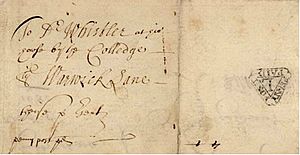Fletcher Collection facts for kids
The Fletcher Collection is an amazing collection of British postage stamps and other postal items. It was put together over a lifetime by a man named Hugh Greenwell Fletcher. He loved collecting stamps, which is also called philately. His collection includes not just stamps, but also things like envelopes and special papers used for mail.
When Hugh Fletcher passed away in 1968, his collection was given to the Bruce Castle Museum in Tottenham. This museum was once the home of Sir Rowland Hill, who is famous for creating the Penny Post. Later, in 1989, the entire collection was moved to the British Library, where it is kept safe and studied today.
Contents
What's in the Fletcher Collection?
This special collection is divided into two main parts. About half of it is made up of items from before stamps were invented. These are called pre-adhesive material.
Early Postal History
One of the oldest items is a letter from 1682. This letter was carried by William Dockwra's original London Penny Post. This was a very early postal service in London where you could send a letter for just one penny. The collection also shows how the government took over this service and used special handstamps.
You can also find examples of early 19th-century mail from something called the "5th Clause Posts." These were special postal services before the famous Penny Post.
The Start of Uniform Postage
The collection has many examples from when postage rates became the same for everyone.
- Uniform Fourpenny Post: There are 73 examples of the 1839-1840 handstamped 4d. This was a new rate that charged fourpence for a letter, no matter how far it went. Some of these items were even used on December 5, 1839, which was the very first day of this new rate! They came from cities like Dublin, Edinburgh, and Glasgow.
- Uniform Penny Post: After the fourpenny rate, the famous Uniform Penny Post began, where most letters cost just one penny. The collection includes rare, privately printed envelopes from this time. Some were made by Baraclough in brown, and others by Buchanan in blue.
Stamps and Stationery
The other half of the collection focuses on actual stamps, mostly used ones.
- Queen Victoria Stamps: It has a wide range of stamps from the time of Queen Victoria. You can see how different printing plates were used to make these stamps.
- Penny Black: This includes examples of every single printing plate used for the famous Penny Black stamp from 1840. The Penny Black was the world's first adhesive postage stamp!
- Postal Stationery: The collection also has postal stationery, which are items like envelopes or letter sheets with the postage already printed on them. There are even complete, uncut sheets of the Mulready 1d and 2d envelopes and letter sheets.
- Mulready First Day Use: One special item is a Mulready 1d lettersheet that was used on May 2, 1840. These Mulready items were first sold to the public on May 1, 1840, so this is a very early example!
- Embossed Envelopes: Later items include envelopes with raised designs (embossed) that also had advertising rings on them.
British Stamps Used Abroad
The collection also shows how British stamps were used in other countries. These include special envelopes that have a mix of stamps from places like the Danish West Indies, Nicaragua, and Beirut.
As of 2008, the entire Fletcher Collection was stored in 341 black boxes at the British Library. It's a huge and important record of postal history!
See also
- British Library Philatelic Collection
- William Dockwra


